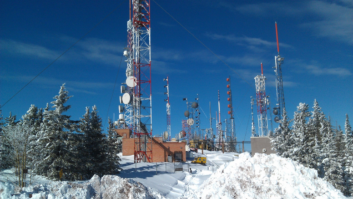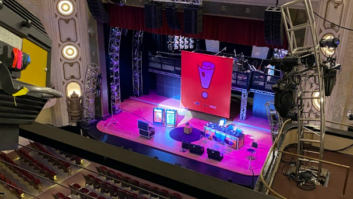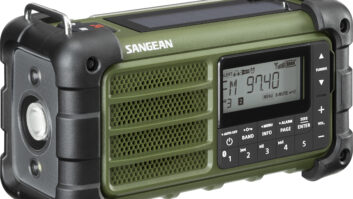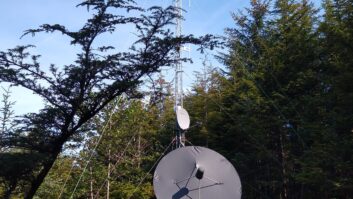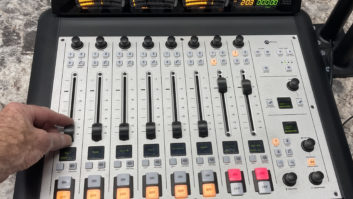In this series of articles, I have often write about big-ticket items — transmitters or consoles/routers. However, that’s not all our work is about; so, instead of talking about the strategic, long-lasting expensive items, let’s look this time at day-to-day tactical items that could save you time or aggravation, or that simply help to keep your station on-air. (For the most part in this roundup, the devices we’ll cover are unrelated.)
PORTABLE POWER
There are innumerable circumstances for which you might need a portable power source. You could be doing a temporary radio shot on a mountain; you could be studying IMD with a spectrum analyzer outside of the fence around some site for which you don’t have access; you could be doing a short remote broadcast.
I really despise portable generators, even when using a company vehicle to carry them around. They’re heavy, dirty and usually smell like gasoline — and I’m not particularly interested in breathing the exhaust fumes all of the time.

Quite often even small portable generators have more capacity than is really needed for the project at hand, so the question becomes: “Can I find something smaller, lighter and that doesn’t stink?” As you might expect, the answer is “yes.”
The Goal Zero Yeti 400 is just one example of a portable power source. It weighs in at 29 pounds, so it’s not exactly light, but it is compact (dimensions are 10.25 inches by 8 inches by 8 inches). It can be charged by plugging into a 120 VAC power source or via a solar panel. As the name suggests, the Yeti 400 has a 400 watt-hour capacity; it comes with two 120 VAC outlets (sine-wave output) along with a 12 VDC and two USB outputs as well. The heart of the device is an absorbent glass mat lead-acid battery, which can be used through hundreds of cycles. The Yeti 400 can be stored plugged in, or plugged in every several times per year for a charge.
HANDHELD ETHERNET TESTER
It’s not hard to find a small Ethernet tester — you can get that at the hardware store, or anywhere they sell componentry and tools for making and installing Ethernet. However, if you want more than that, you’ll need to look beyond the big box stores.
The NetScout Linksprinter is one such device and really fits in the palm of your hand. Its salient features:


Power-over-Ethernet tester. Linksprinter allows you to make sure you can power a VoIP phone, security camera or Access Point through a specific port. The LinkSprinter Network Tester can run without batteries on PoE.
Link to the switch. Perform a switch test, which returns the switch name, model, slot, port and VLAN to which you are connected to using CDP/LLDP/EDP. Know your available speed and duplex settings.
DHCP connection. Confirm that the DHCP server is running and responsive: Request an IP address, get your subnet information, identify the default gateway and DNS server.
Gateway connection. Verify the gateway/router address and reachability by pinging the device.
View detailed network test results on your mobile device. The LinkSprinter 200/300 network tester results can be accessed through the browser of any mobile device via its built-in Wi-Fi modem. A companion application for the NetScout LinkSprinter 200/300 network tester will automatically connect to the LinkSprinter’s SSID and display detailed results of the network test.
REMOTE SITE AIR MONITOR
In this day and age, it’s quite likely you have a remote transmitter site that just can’t be received very well at your studio location. The site might be far — the signal somewhat weak — or have any number of other reception issues
Another problem many of us have is that there are just too many signals to monitor on a daily basis. Here’s the nightmare scenario: One day your PD sends you a message. “Hey — listeners are texting us from Little City saying the station sounds funny. What’s going on?” Well, you’re nowhere near the station in Little City, and there’s no way you can hear it. You could drop everything else you’re doing and drive all the way out there, using up an inordinate amount of precious time and likely getting caught in traffic; or you could take a proactive approach and install a remotely-accessible air monitor receiver that allows you to be in two places at the same time.
The INOmini 638 from Inovonics is one such device that enables this kind of remote access. It’s IP-enabled and thus accessible from anywhere you can get on the internet. You open up a browser, point it to this remote receiver, and stream its demodulated audio (for FM or any of its HD Radio streams).

One of two things happens: either the station sounds normal, after which point you can tell your PD that all is well up there. (Remember to check the log to see if something was going on and has already resolved itself.) You can also see signal metrics, like strength, to see if all looks well, and you can also check RDS and PSD associated with HD Radio.
Now let me suggest an even more proactive approach. The 638 can be set to email or text you with error messages associated with signal loss, audio loss, pilot loss, HD loss or RDS errors.
Instead of your PD sending you cryptic messages catching you unaware, you can tell him/her “Yes — I already know about it. We’re working to resolve the problem now.” That’s the kind of response they love.
If you happen to have a remote control that supports SNMP, you can configure it to “talk” to the 638 by SNMP, thus providing an additional way to see what is going on at your remote site. By periodically querying the remote site from your remote control, you can actively monitor the health of the connectivity to the remote site.
HEADPHONES AND TALKBACK FROM A REMOTE
If you do a lot of remotes with talent who are constantly talking back to the station (say, for sports or news), then you know having a consistent and reliable set up of remote gear is an absolute necessity.
There’s an easy way to combine quite a bit of your functionality in to one box — for example, by making use of the Whirlwind THS 4, a talkback/headphone box that is an all-purpose announcer console.

The THS 4 has both main and talkback microphone outputs. A latching mic on/off switch connects signal to the main mic output. The switch is illuminated red when the mic output is live. (36 Volt phantom power is available, if condenser mics are used, and the switch to turn phantom power on and off is recessed to avoid accidents.) A momentary cough switch silences both the mic out and the talkback out when depressed. The momentary Talkback switch connects audio to the talkback output while muting the mic out. The announcer’s microphone is sent through a preamp and line driver that delivers the signal to the talkback output at line level. (There is a level control for fine adjustment of the audio sent down the talkback line.) The Talkback switch illuminates green when depressed.
The headphone section of the THS 4 has two inputs: Each input has a volume control and dip switches to send the signal to the left and/or right headphone earpieces. When an input is assigned to both ears, level adjustments affect both left and right ears equally. Input signals can be either balanced mono or unbalanced stereo. A rear panel switch selects the proper mode. Both 3-pin XLR and 1/4-inch TRS input jacks are provided for hookup flexibility. Headphones with impedances ranging from 30 to 600 Ohms can be driven to full volume.
AES SPLITTING TRANSFORMER SET

Practically from the first day we started using AES data streams, we’ve needed the same stream to show up in more than one place or to feed more than one source. AES distribution amplifiers made their appearance early on — but are they really necessary?
It really depends on the circumstances — if you need the same AES stream to show up in, say, eight places — you likely need a DA or even a TDM-based or AoIP router. If you need to have two or perhaps three appearances of the same data stream, the circumstances favor AES splitting transformers.
Like transformers that split analog output signals, the ones that split AES streams also diminish the level of the signal on the outputs; however, unlike analog audio, that lower level doesn’t translate in to a difference in the information conveyed by the signal. In other words, -10 dBFS is still -10 dBFS whether the peak-to-peak digital data is 5V or .5V. (If you’re a skeptic, please consider reading this article on AES splitting transformers: http://tinyurl.com/jytd5x4.)
Sonifex makes a single-RU, four-way, three outputs-per-transformer AES splitter that you should know about — the AES4X3. This transformer set is a good way to eliminate single points of failure since it is, of course, completely passive.
I have seen in my travels one powered AES DA that fed more than one air-chain. I don’t think I have to tell you that’s a bad system design. No 20-cent fuse can accidenatlly blow in the AES4X3 panel, taking your station off-air; it essentially does the same thing as a powered DA but without the inherent risks of power supply failure.
AES SWITCHER AND DISTRIBUTION
To get away from single points of failure one should use parallel air chains. Now, if at your studio you have multiple sources (studios and/or automation outputs) from which to choose, some sort of switcher is a necessity, and the preferred method is to have one switcher per air-chain.

BDI’s AES-404 is a good example of this type of switcher. It has four AES-3 type inputs; two AES-3 type outputs, and a built-in D/A converter (up to 192 KHz S.R and 24-bit word length) that drives a set of balanced audio outputs with a +4 dBm output level corresponding to -20 dBFS. The decoded audio is also available on the front panel headphone output. The AES404 features complete error flag information with memory retained to aid in troubleshooting: Slipped sample, CRC error, parity error, coding error and unlock status are available. (There is a sample rate indicator included too.)
Since studio problems that would prompt you to use a switch like this will most likely happen when you are not at work, it’s important to note that the AES404 has remote control capability — either via GPIO or RS232/485.
With multiple sources feeding multiple switches, some means of distributing the AES streams is called for — the AES4X3 would make a great companion to a switcher like the AES404.
While the big consoles and transmitters make up the heart and soul of a radio station, it’s the small items — like some of the ones mentioned above — that often provide the fuel that keeps the station humming along. More often than not they make the difference between an facility that is good and one that is really great.





